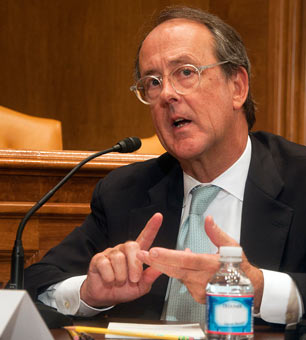In recent weeks, Alan Simpson, the foul-mouthed former senator, has apparently been sent to the sidelines. It seems that his inability to restrain his contempt for those who are now or will in the future be dependent on Social Security and Medicare makes him an undesirable spokesperson for the drive to cut back these programs. This means that Erskine Bowles, who was the other co-chair of President Obama’s deficit commission, will play a more visible role in pushing the cause.
While Mr. Bowles is clearly better able to control his temper and his vocabulary than Senator Simpson, those are not sufficient credentials for dictating the future shape of the Social Security and Medicare systems. Despite the deference accorded Bowles in elite Washington circles, in the rest of the country his background might be seen as more a source of embarrassment than a badge of honor.
In particular, people should have cause for concern about his track record as a director of Morgan Stanley, the huge Wall Street investment bank. Morgan Stanley is one of the major investment banks that played a central role in propelling the housing bubble. In the years 2002-2006, as house prices were soaring into the stratosphere and mortgage standards were falling through the floor, Morgan Stanley was buying up tens of billions of dollars of junk loans and packaging them into mortgage-backed securities to be sold across the globe.
Bowles joined the party in December of 2005, when the frenzy was approaching a peak. Mr. Bowles was well-compensated for his work. In 2008 he pocketed $335,000 for his duties. This sum is more than 270 times the average monthly Social Security check of $1,200. In other words, Mr. Bowles was paid more money from Morgan Stanley in 2008 than most Social Security beneficiaries will collect throughout their entire retirement.
Some folks may recall that 2008 was the year that the financial system nearly melted down. Morgan Stanley was at the center of this meltdown. After Bear Stearns collapsed in March of that year, followed by the bankruptcy of Lehman in September, Morgan Stanley was standing in line as one of the three remaining independent investment banks.
An investment bank specializes in underwriting stocks and bonds. It does not take checking and savings deposits like the commercial banks where most of us have accounts. For this reason, it does not have to deal with the scrutiny of the bank regulators, nor does it enjoy the protection of the Federal Reserve Board or the Federal Deposit Insurance Corporation (FDIC).
When the financial crisis was reaching its peak, this lack of protection was a huge liability. There was effectively a run on Morgan Stanley as creditors no longer trusted that the bank could repay its debts. At that time, the bank was desperately looking for a deep-pocketed buyer who could stem this run.
With no obvious candidates to buy this sinking behemoth, Federal Reserve Board Chairman Ben Bernanke stepped in and allowed Morgan Stanley to become a bank holding company. This meant that the bank could now enjoy the protection of both the Fed and the FDIC. This government protection reassured investors and stemmed the bank run.
This history is noteworthy because it is a record of disastrous failure. Morgan Stanley would have gone bankrupt; it would be out of business, had it not been for the enormous generosity of Washington. In the fall of the 2008, the guarantees and below-market loans provided to Morgan Stanley by the Fed, the FDIC and the Treasury were of enormous value. (Imagine if the Fed guaranteed the mortgages of underwater homeowners.) In effect, this was a transfer of billions of dollars from the taxpayers to the top executives, the shareholders, the creditors and the directors of Morgan Stanley.
Bowles’ job as a director of Morgan Stanley was to make sure that nothing like this happened. He was paid a huge salary to make sure that the company’s top management was following sound business practices. He failed just about as badly as a person possibly could.
Directors are also supposed to make sure that top management does not enrich themselves at the expense of shareholders. Remember, the directors ostensibly work for the shareholders and oversee top management.
It doesn’t look like Mr. Bowles and his co-directors did a very good job in this category either. John J. Mack, the bank’s CEO, collected $25 million in bonuses for his work in 2005 and $40 million for his work in 2006.
This is the track record that Bowles brings to his work as co-chair of President Obama’s deficit commission. This person, who was paid so incredibly well to oversee the operations of a bank that required a government bailout to stave off collapse, is telling us that we have to take a cut in Social Security and make Medicare less adequate. And the elite wonder why the public has contempt for Washington.
Join us in defending the truth before it’s too late
The future of independent journalism is uncertain, and the consequences of losing it are too grave to ignore. To ensure Truthout remains safe, strong, and free, we need to raise $47,000 in the next 8 days. Every dollar raised goes directly toward the costs of producing news you can trust.
Please give what you can — because by supporting us with a tax-deductible donation, you’re not just preserving a source of news, you’re helping to safeguard what’s left of our democracy.
